class: center, middle, inverse, title-slide .title[ # Humans and Wildlife: A Deep (pre)-History ] .subtitle[ ## EFB 390: Wildlife Ecology and Management ] .author[ ### Dr. Elie Gurarie ] .date[ ### September 2, 2025 ] --- class: center <!-- https://bookdown.org/yihui/rmarkdown/xaringan-format.html --> # Hominoidea  --- # Zoom in on Hominini  --- # Note the Pliocene-Pleistocene transition 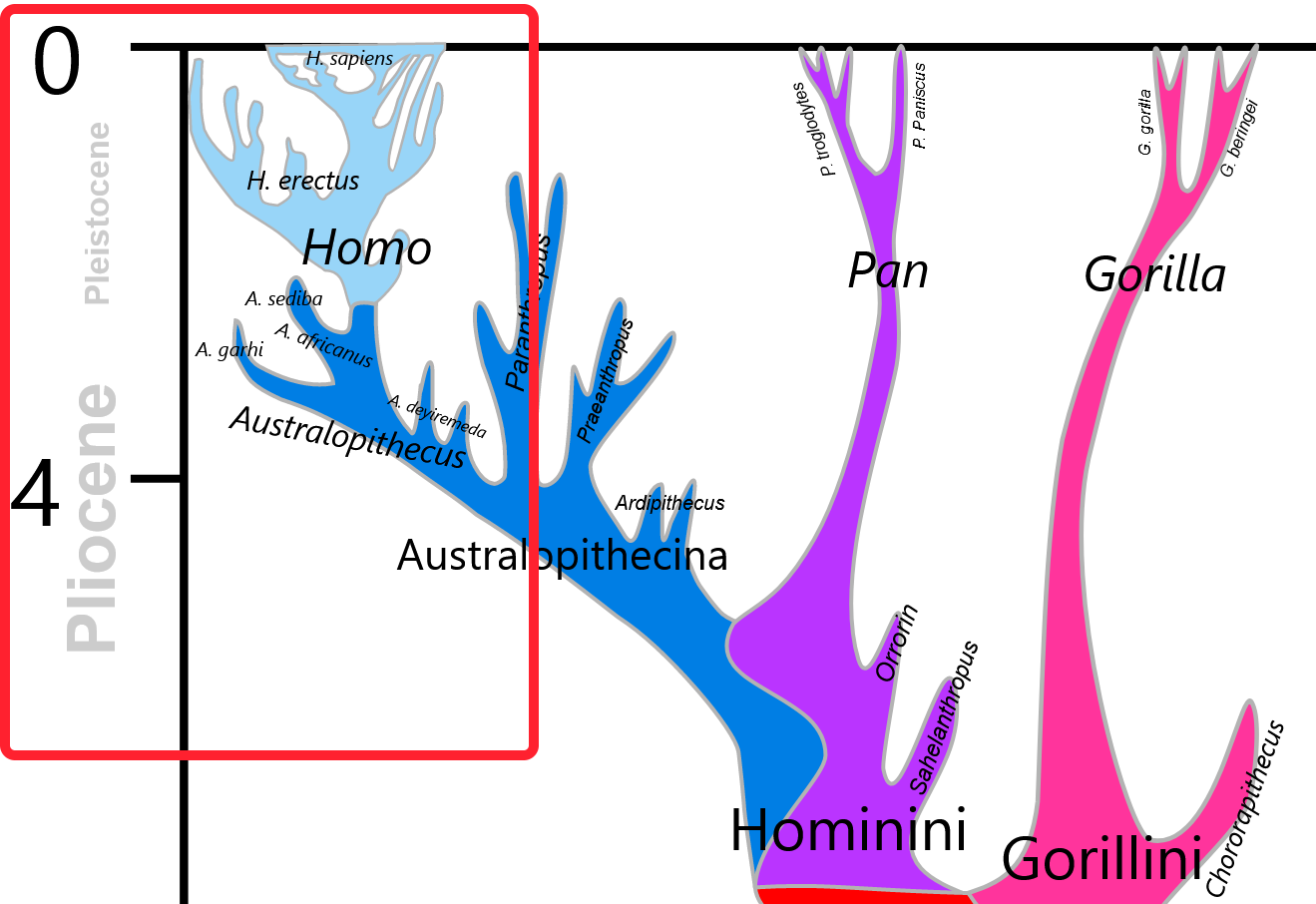 --- # The Pliocene (5.3-2.6 mya) was warm ... 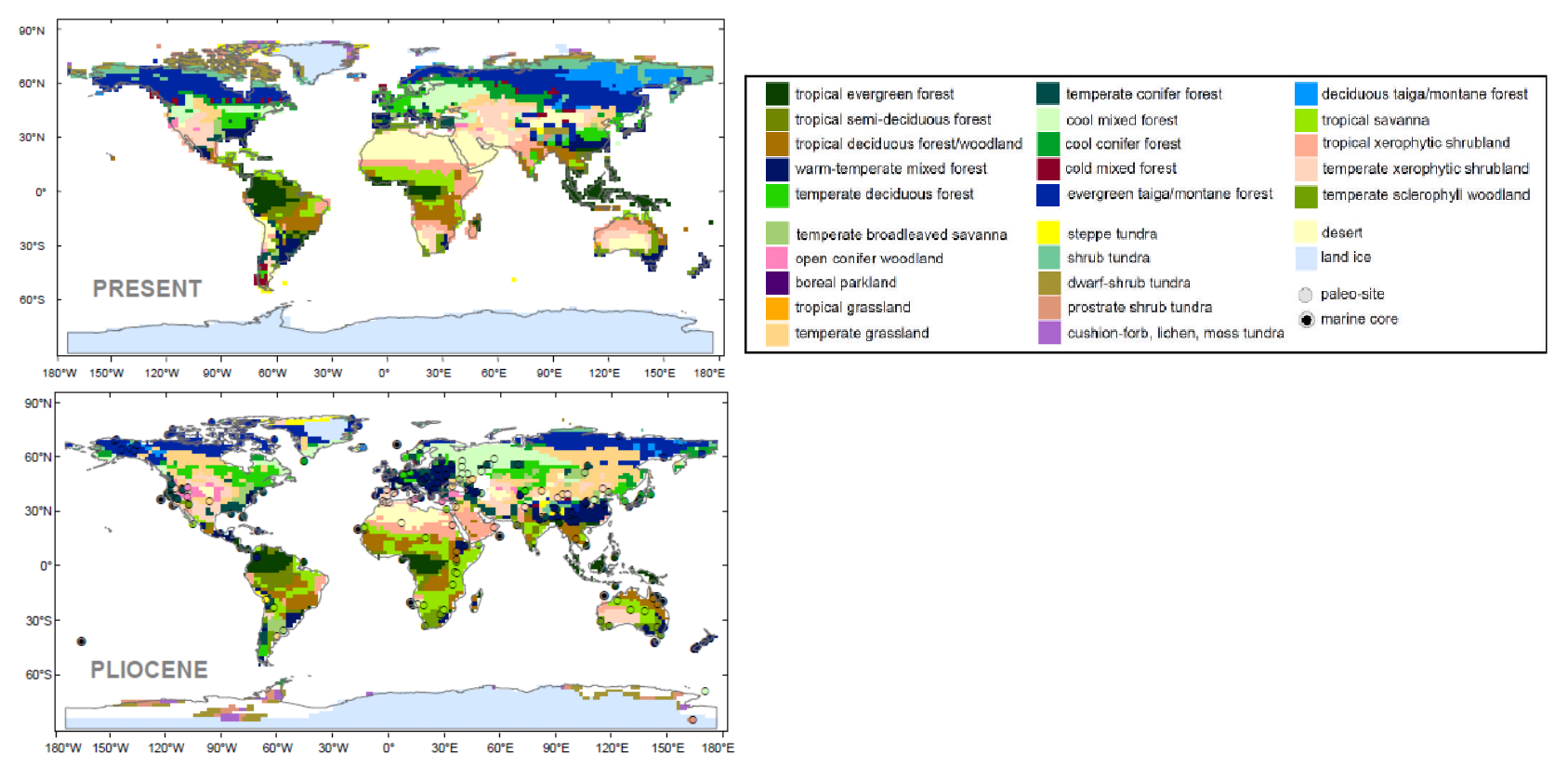 .footnote[(Salzmann et al. 2011)] --- # ... about 2-4°C warmer ... 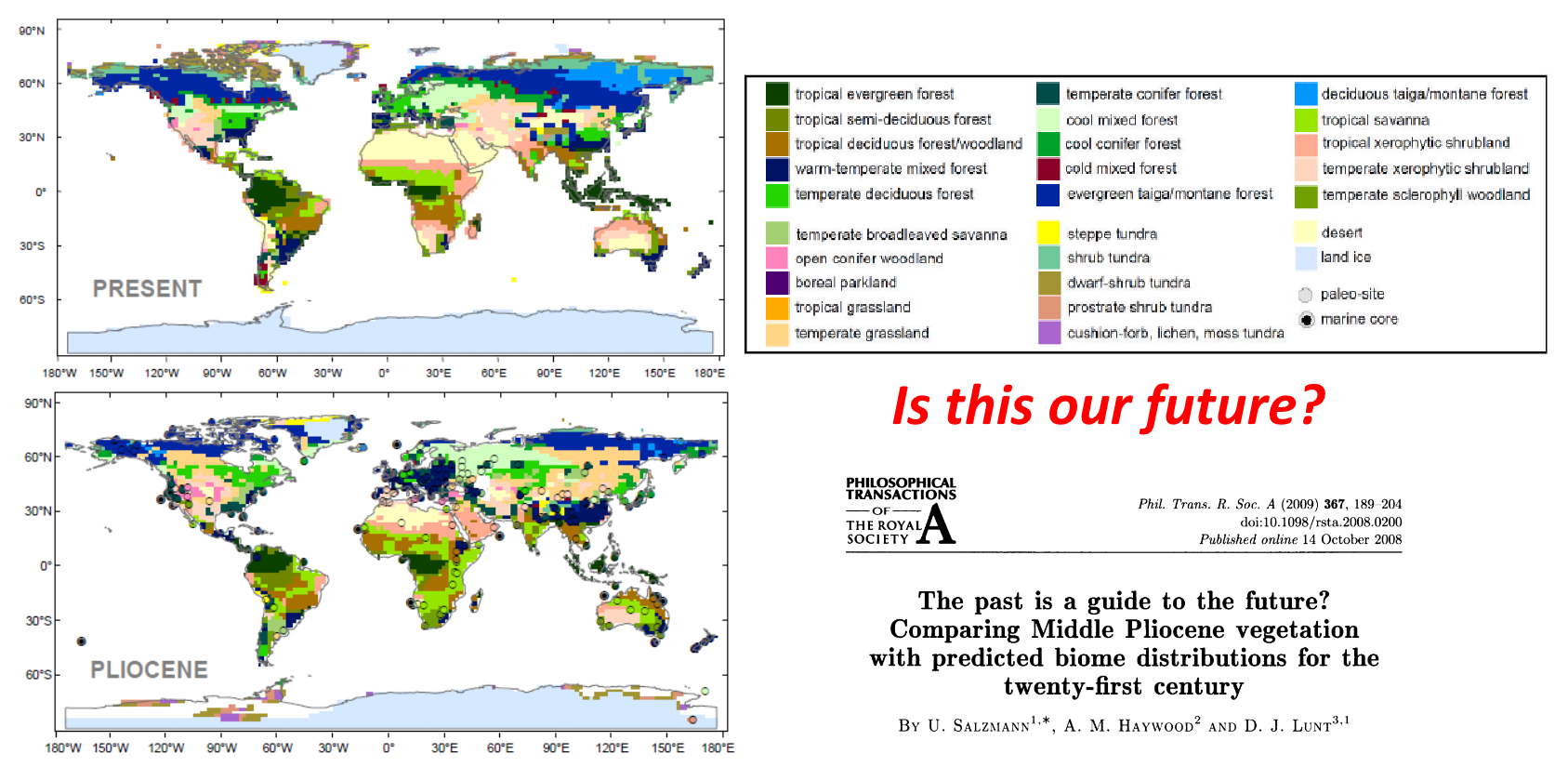 .footnote[(Salzmann et al. 2011, 2009)] --- # ... but cooling .pull-left-70[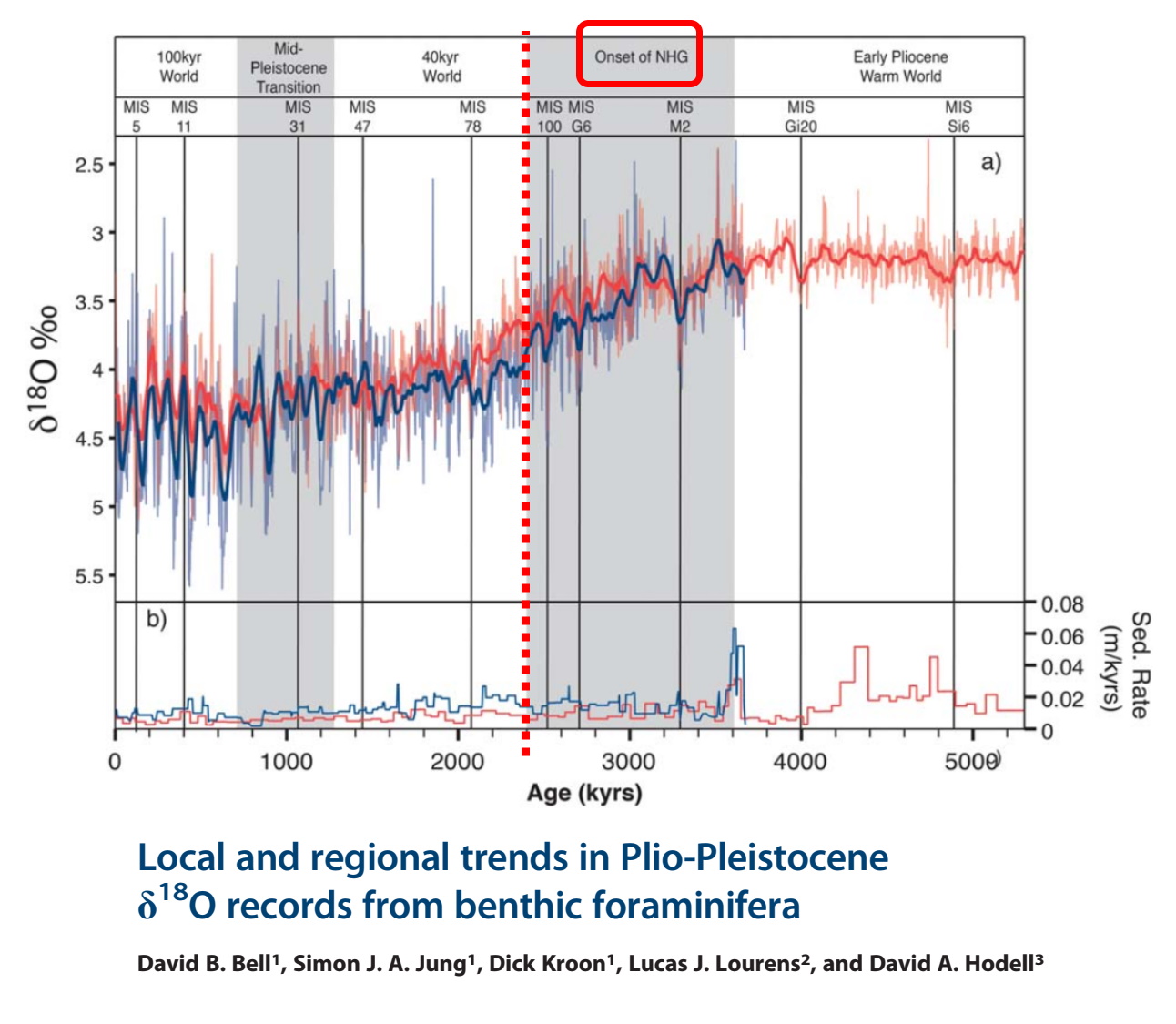 .center[([Bell et al. 2014](https://agupubs.onlinelibrary.wiley.com/doi/full/10.1002/2014GC005297))] ] .pull-right-30[ Note: .blue[Backwards *time* axis!] .green[Upside-down *y*-axis!] .red[NHG = Northern Hemispheric Glaciation] ] --- # Leads to some questions ... .pull-left-40[ ### What is .green[δ<sup>18</sup>O]? ] .pull-right-60[ ### What are .blue[benthic foraminifera]? 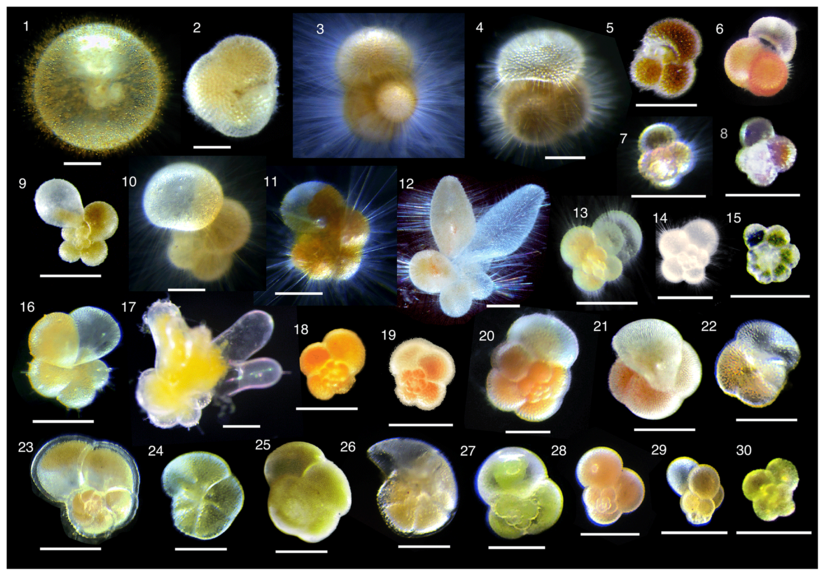] ### .center[And how do they tell us what the climate was many **mya**? ] --- ## Leading to Pleistocene (~2.58 mya `\(-\)` 11.7 kya) #### Pulses of major expansion of glaciation (*Ice Ages*) and retreats 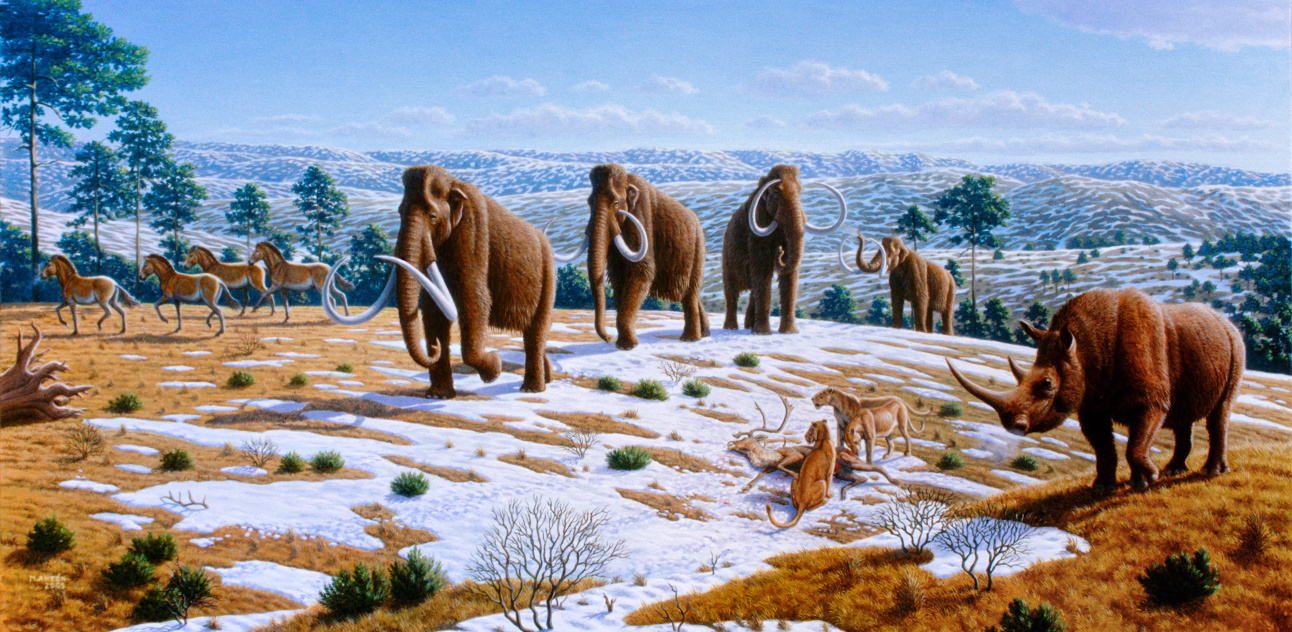 .small[**Nomenclature near-fail:** *Pliocene* means "new age", *Pleistocene* means the "newest age", *Holocene* means "entirely new" ... which, really!?] .footnote[painting: Mauricio Antón] --- ## Pleistocene famously the age of mammalian giants  --- ## Brief intro to one biome: The Mammoth Steppe <iframe src="https://www.youtube.com/embed/RXAirenteRA?controls=0" width="100%" height="400" frameborder="0" allowfullscreen> </iframe> --- ## What does this mean for hominids?  - **Africa** becomes LESS forested more steppe / savannah / grassland. - **Explosion** of large herbivore (grazing) populations .footnote[] --- ### Cooling `\(\to\)` Grasslands `\(\to\)` Herbivore Speciation `\(\to\)` Hominid divergence <img src="images/AfricaSummarized.png" width="90%" style="display: block; margin: auto;" /> .footnote[ [deMenocal 2004](https://www.sciencedirect.com/science/article/pii/S0012821X04000032?via%3Dihub) ]] --- class: inverse ## Ever since Darwin ... .pull-left-60[ #### the main idea has been: 1. hominid ancestors abandoned trees ... 2. became bipedal ... 3. used free hands to make tools ... 4. which they used to **hunt** ... 5. which stimulated language / cooperation / civilization, etc. #### corrolaries 1. males hunt (and are stronger/smarter/etc.) 2. females gather #### “meat made us human” hypothesis ] .pull-right-40[ 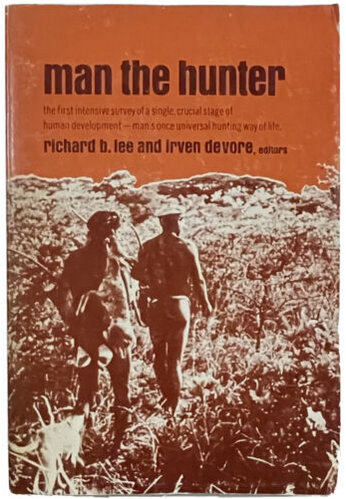 ] .footnote[Darwin 1871] --- ## Alternative more nuanced hypothesis ... *scavenging* .pull-left[ During Pliocene - Pleistocene transition, increased seasonality in precipitation lead to vegetative food-source bottlenecks. Food diversification turned .blue[*Paranthropus*] to exploit seeds, roots, sedges ... .red[*Homo erectus*] turned to meat carcasses left behind by large carnivores. ] .pull-right[ 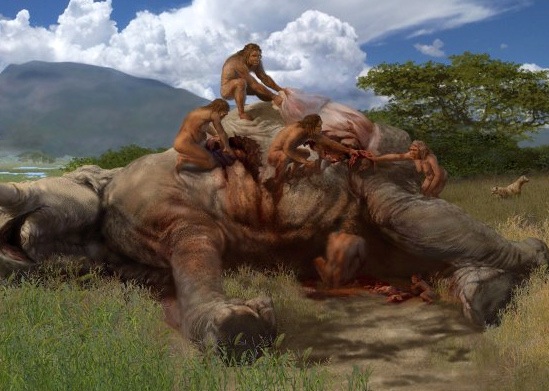 ] -- Evidence includes: - (1) the fact that most early tools are **butchering** tools not **hunting** tools. - (2) Predators of large herbivores almost always leave plenty to scavenge. - (3) Scavenging is **easier**, even without fancy tools. Consequence: Cooperation and communication and rapid divergence from other early hominids. .footnote[[Pobiner 2014](https://www.sciencedirect.com/science/article/pii/S0047248414002656?casa_token=Fj_0rRYr4k8AAAAA:qMIiYcoELqr1SsIBQgToNXiYs0Lo6aXrPGt_zF51HcCXjY_7jT_-joV1qczCIF9hkoUO2mFwctQ)] --- # Active research and debates! .pull-left-70[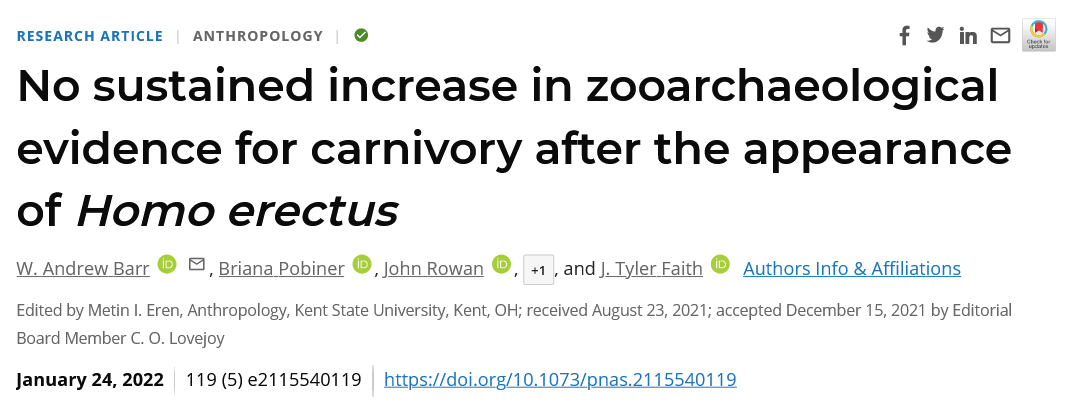]  Interesting [podcast](https://www.si.edu/sidedoor/did-meat-make-us-human), also about how certain beliefs persist in science, and also how results are represented / misrepresented in current information-sphere. .footnote[[Barr et al. 2022](https://www.pnas.org/doi/abs/10.1073/pnas.2115540119)] --- ## Either way ... eventually humans became VERY good hunters .pull-left[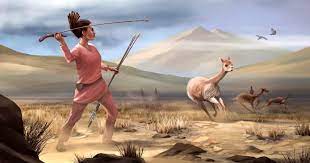] .pull-right[ .large[including plenty of females.] .content-box[.small[*In societies where hunting is considered the most important subsistence activity, women actively participated in hunting 100% of the time.*]] ] .pull-left-60[  .footnote[ - [Haas et al. 2020](https://www.science.org/doi/10.1126/sciadv.abd0310) - [Anderson et al. 2023](https://journals.plos.org/plosone/article?id=10.1371/journal.pone.0287101) ]] .pull-right-40[ 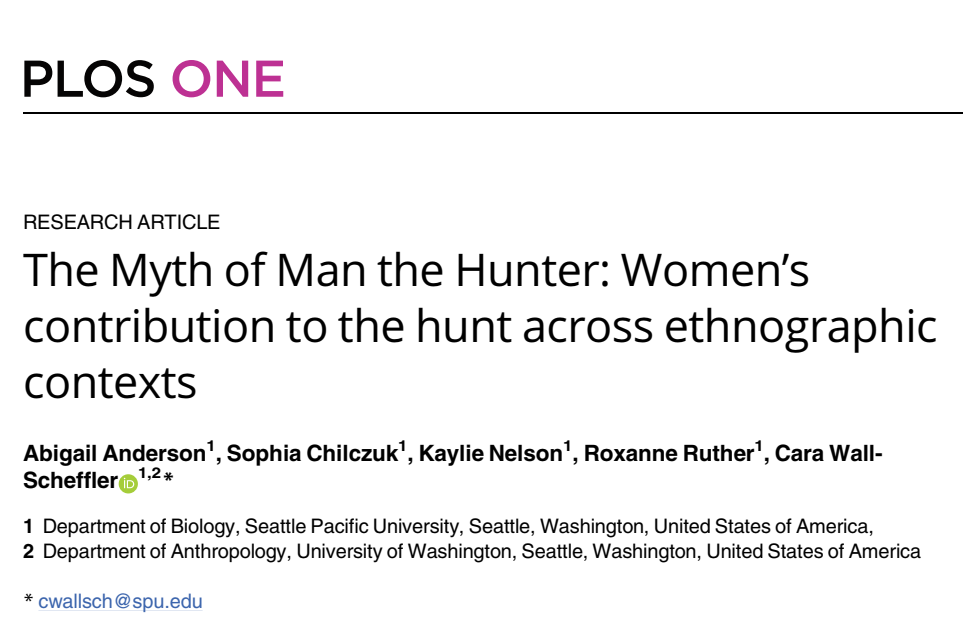 .footnote[ ] ] --- ## Extinct megafauna (>100 kg) 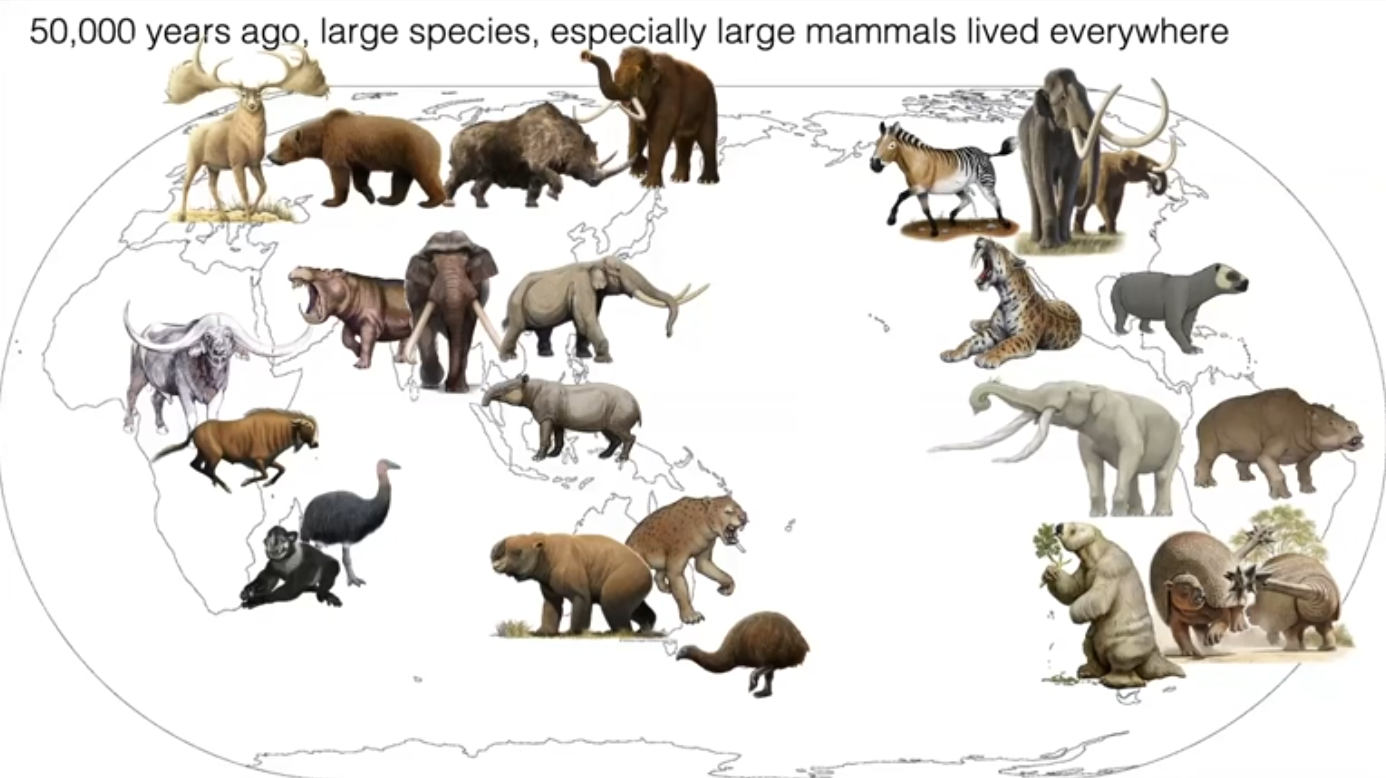 --- ## And most of the megafauna goes extinct .center.large[***note the size bias!***] 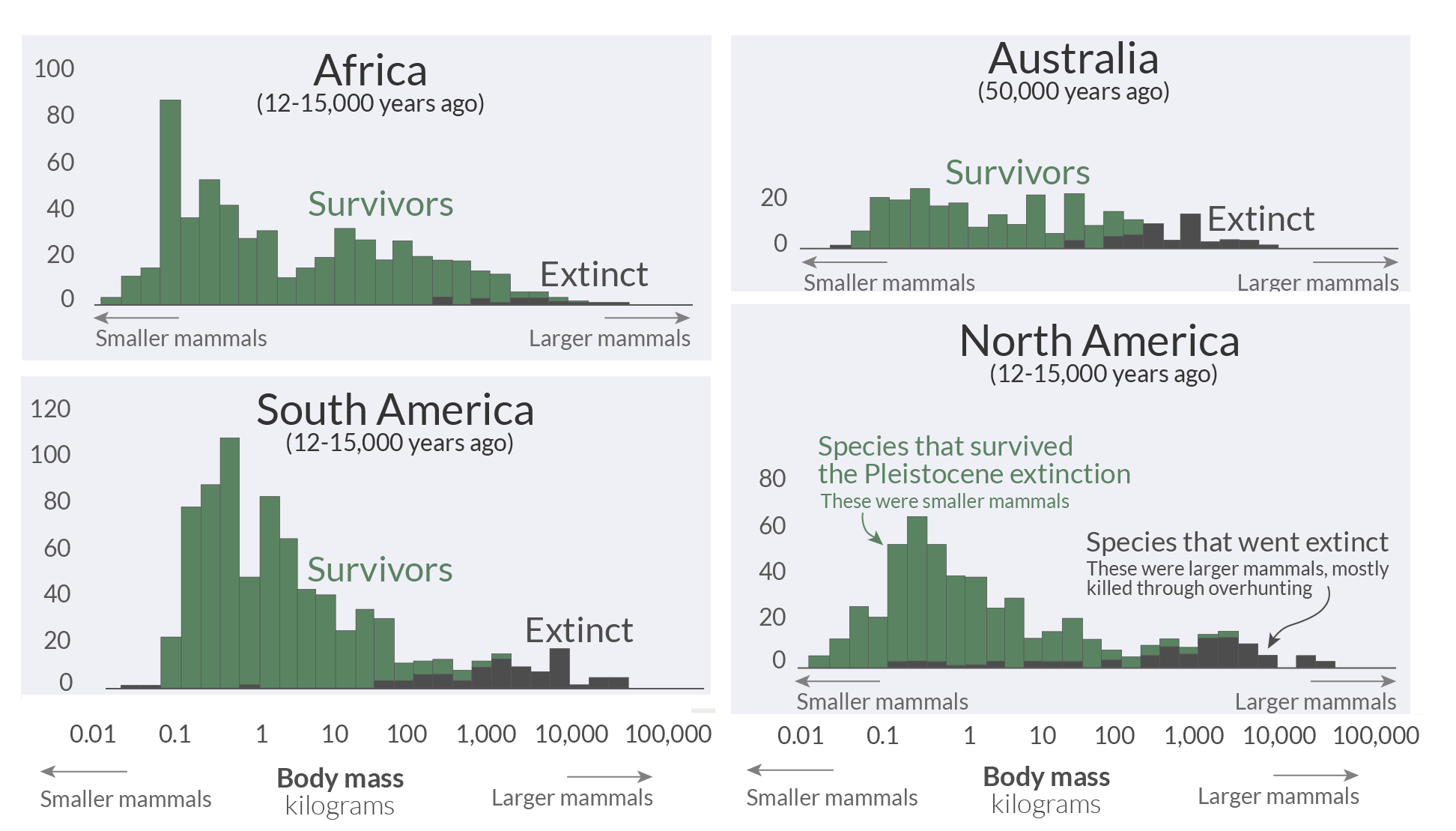 (also, the **log-scale** of mammal mass) --- ## And most of the megafauna goes extinct  **Quaternary Megafauna Extinction** - killed 2/3 of mammal genera & 1/2 of all species >44 kg. - between 50,000 - 3,000 ya .small.center[([Dirzo et al. 2014](https://www.science.org/doi/10.1126/science.1251817))] --- ## Compare location of extinct megafauna  --- ## To extant megafauna 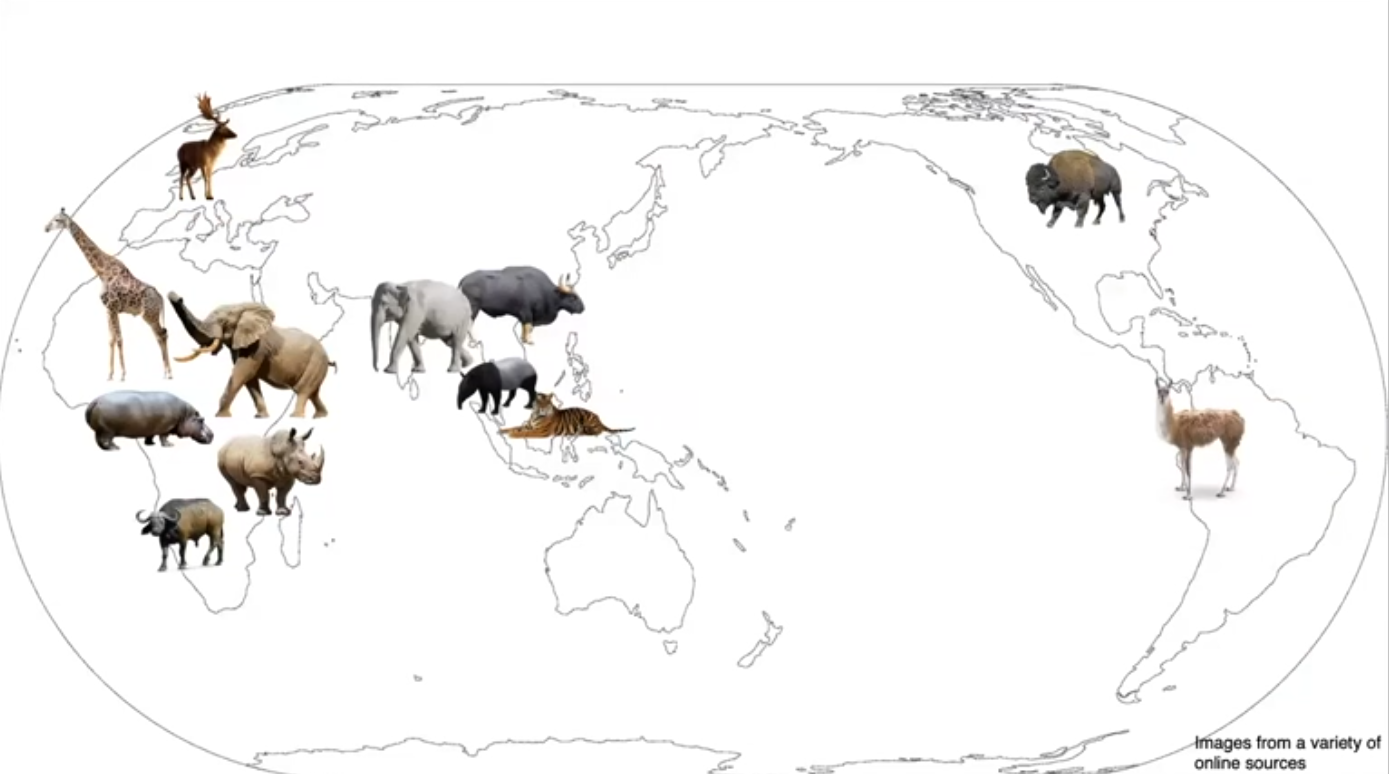 --- ## Global human dispersal ... followed by extinctions 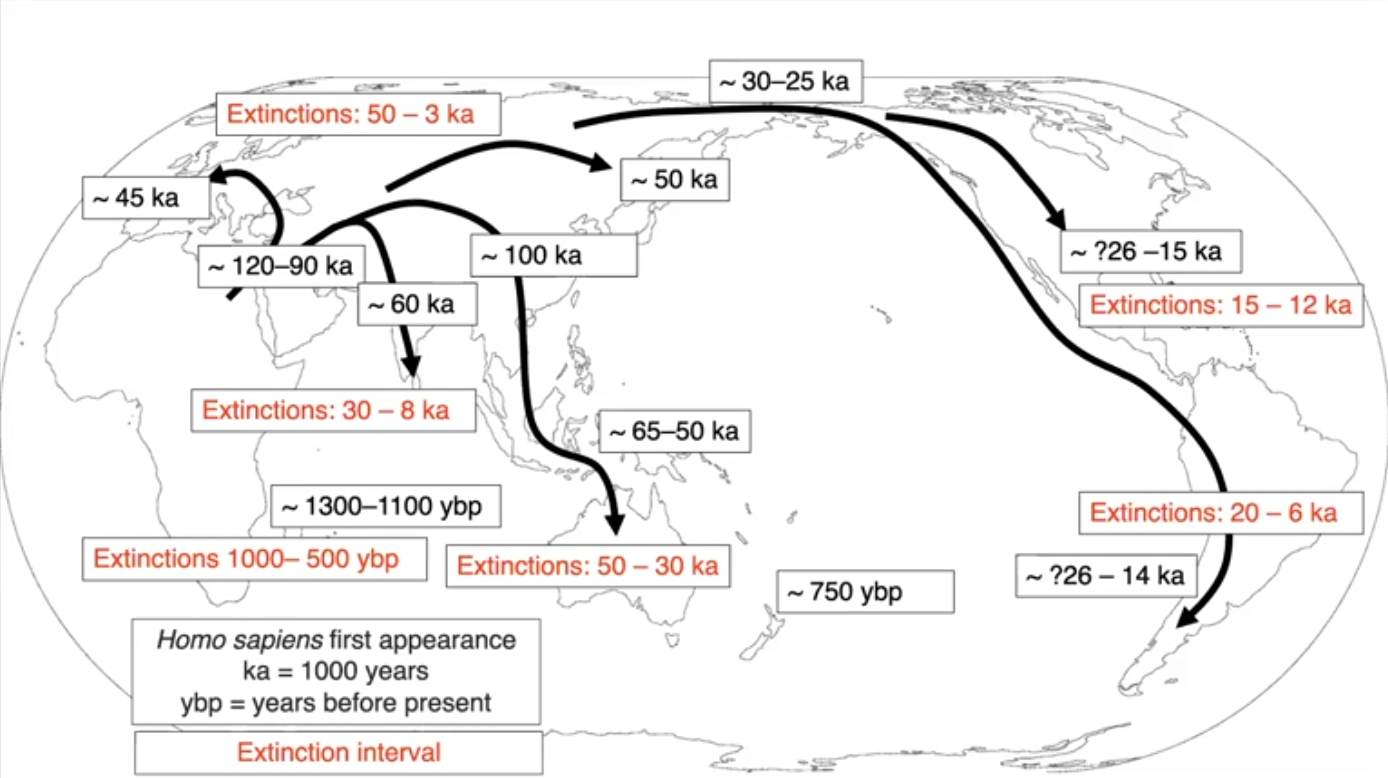 --- ## Was it humans or climate? <iframe src="https://www.youtube.com/embed/RXAirenteRA?start=167" width="100%" height="400" frameborder="0" allowfullscreen> </iframe> (start at 2:46) --- class: small ## Longer co-existence -> relatively less extinction 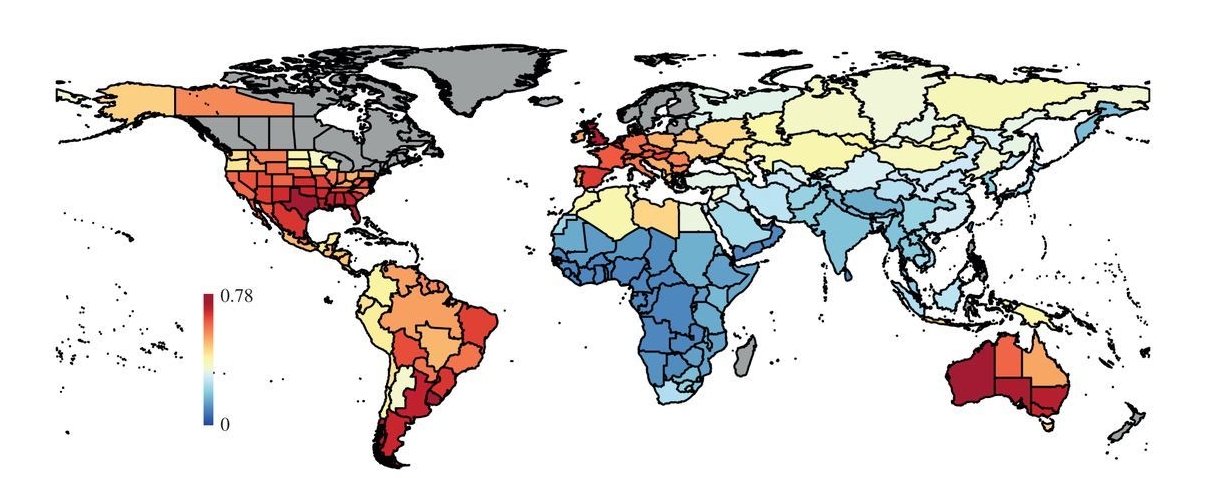 .footnotesize[ region | extinction (genera) ---|--- **Subsaharan Africa:**| 4.5% (2 / 44) **Indian Subcontinent:**| 13.8% (4 / 29) **Europe:** |30.4% (7 / 23) **North America:**| 73.3% (33 / 45) **South America:**| 79.3% (46 / 58) **Australia and New Guinea:**| 93.8% (15 / 16) ] . --- ## Climate and/or humans? 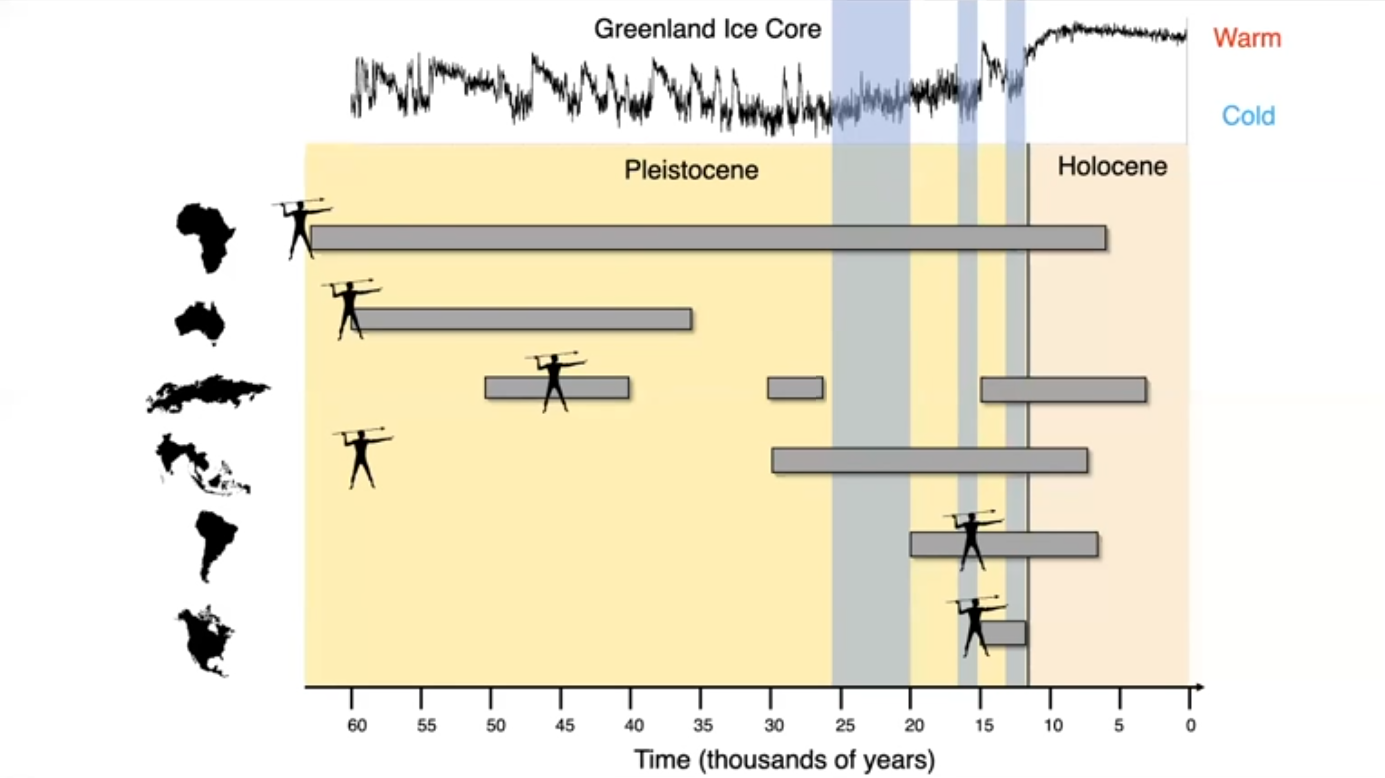 <center> (kind of a smoking ... spear?) --- ## Does climate play *some* role?  Woolly Mammoth (*Mammuthus primigeneris*) habitat fragmentation ... leads to higher **risk** when human X-factor arrives. --- ## Does size play a role? .pull-left[ .large[ - Long gestation time - Long inter-birth intervals - Small litters - Delayed age to maturity Also leads to higher **risk** of extinction once human X-factor arrivess.]] .pull-right-40[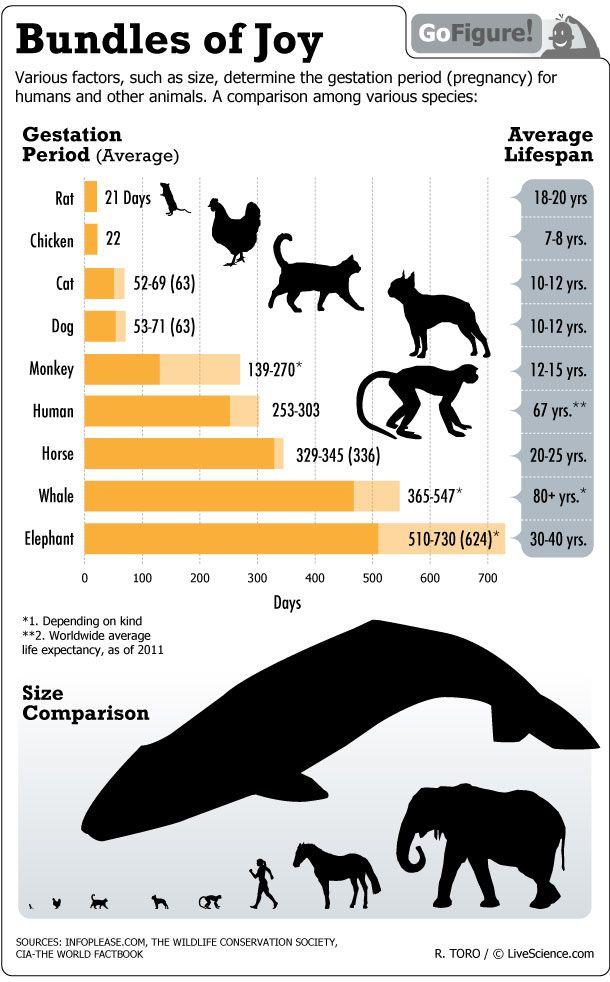] --- class: inverse ## Take-aways ... .large[Hominids **are** animals, and have obviously always interacted ecologically with other animals.] -- .large[Climate-driven changes in vegetative ecology led to a major shift in diets towards meat and marrow, and major consequences for hominid evolution.] .red[(With debate was it **hunting** or **scavenging**)] -- .large[In combination with **climate change** and **reproductive biology/physiology**, even small numbers of humans can cause major extinctions.] .red[(with debate as to the relative importance of **hunting** vs. **climate change**)] -- .large[In places with long histories of co-evolution (esp. Africa) historic humans were able to coexist with highly diverse megafauna.] --- class: inverse ## Take-aways re. science **Paleontology** (paleoecology, paleaoclimatology, etc.) requires: - HIGHLY patchy, incomplete and hard to obtain and interpret data (esp. **fossil remains**) -- - fancy **technology**, esp. for dating, reconstructing climate and, increasingly, DNA sequencing. -- - sophisticated **modeling** of (global) climate & vegetation -- - understanding of climatology, biogeochemical cycles, global ecology, basic ecology, human and animal behavior (for **modern analogues**). -- - Lots and lots of guesswork, argument building, and debate! -- .yellow[In the end - obviously - there is **lots** we'll never know, but it is **impressive** the stories that can be inferred!] --- background-image: url("caveart/caveart.webp") background-size: cover ## .white[Humans have always cared **a lot** about wildlife] --- background-image: url("caveart/caveart2.webp") background-size: cover ## .white[Humans have always cared **a lot** about wildlife] --- background-image: url("caveart/caveart4.webp") background-size: cover ## .white[Humans have always cared **a lot** about wildlife] --- background-image: url("caveart/lascaux2b.jpg") background-size: cover ## .white[Humans have always cared **a lot** about wildlife] --- background-image: url("caveart/caveart_mammoth.jpg") background-size: cover ## .white[Humans have always cared **a lot** about wildlife] --- class: inverse ## Much higher-level question ... ### Can we leverage our paleo-ecological knowledge to mitigate climate change? <iframe src="https://www.youtube.com/embed/RXAirenteRA?start=167" width="100%" height="400" frameborder="0" allowfullscreen> </iframe> <center>Start at 8:39</center> --- class: inverse ## Homework Assignment .pull-left-30[ (posted on [Blackboard](https://blackboard.syracuse.edu/ultra/courses/_531605_1/outline/assessment/test/_10466898_1?courseId=_531605_1&gradeitemView=details)) 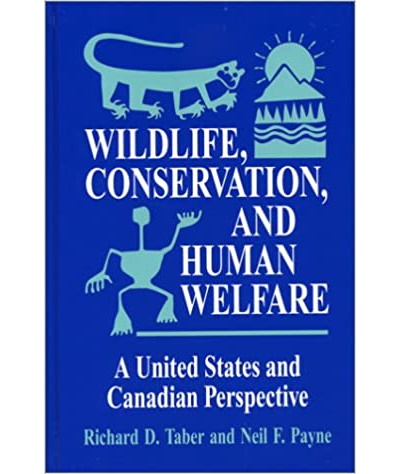 Fascinating, old, but **poorly referenced** book. ] .pull-right-70[ - Find **3 statements** from Chapters 1-2 of the book that make you raise your eyebrow or wonder “*How in the heck do they know that?*”, and that need an inline citation one way or another. At least one statement from each chapter. - For **each claim**, find at least **two references** that either support or refute the claim. The references cannot be from the end-of-chapter bibliography, and must be more recent than 2000. Store that reference in **Zotero**. - Write a brief report, quoting each claim and explaining what evidence or argument the reference supports or refutes. Cite the references in write-up using the *Ecology* style, as shown in recitation (in-text citations and literature cited list). ] --- ## References I .footnotesize[ - Anderson, A., Chilczuk, S., Nelson, K., Ruther, R., & Wall-Scheffler, C. (2023). The Myth of Man the Hunter: Women’s contribution to the hunt across ethnographic contexts. *PLOS ONE, 18*(6), e0287101. https://doi.org/10.1371/journal.pone.0287101 - Bell, D. B., Jung, S. J., Kroon, D., Lourens, L. J., & Hodell, D. A. (2014). Local and regional trends in Plio-Pleistocene δ¹⁸O records from benthic foraminifera. *Geochemistry, Geophysics, Geosystems, 15*(8), 3304–3321. https://doi.org/10.1002/2014GC005297 - Broughton, J. M., & Weitzel, E. M. (2018). Population reconstructions for humans and megafauna suggest mixed causes for North American Pleistocene extinctions. *Nature Communications, 9*(1), 1–12. https://doi.org/10.1038/s41467-018-07897-1 - Darwin, C. R. (1871). *The descent of man, and selection in relation to sex* (1st ed., Vol. 1). John Murray. - de Menocal, P. B. (2004). African climate change and faunal evolution during the Pliocene–Pleistocene. *Earth and Planetary Science Letters, 220*(1–2), 3–24. https://doi.org/10.1016/S0012-821X(04)00003-2 - Dirzo, R., Young, H. S., Galetti, M., Ceballos, G., Isaac, N. J., & Collen, B. (2014). Defaunation in the anthropocene. *Science, 345*(6195), 401–406. https://doi.org/10.1126/science.1251817 - Domínguez-Rodrigo, M. (2002). Hunting and scavenging by early humans: The state of the debate. *Journal of World Prehistory, 16*(1), 1–54. https://doi.org/10.1023/A:1014507129795 ] --- ## References II .footnotesize[ - Nogués-Bravo, D., Rodríguez, J., Hortal, J., Batra, P., & Araújo, M. B. (2008). Climate change, humans, and the extinction of the woolly mammoth. *PLoS Biology, 6*(4), e79. https://doi.org/10.1371/journal.pbio.0060079 - Reed, K. E. (1997). Early hominid evolution and ecological change through the African Plio-Pleistocene. *Journal of Human Evolution, 32*(2–3), 289–322. https://doi.org/10.1006/jhev.1996.0106 - Salzmann, U., Haywood, A. M., & Lunt, D. J. (2009). The past is a guide to the future? Comparing Middle Pliocene vegetation with predicted biome distributions for the twenty-first century. *Philosophical Transactions of the Royal Society A: Mathematical, Physical and Engineering Sciences, 367*(1886), 189–204. https://doi.org/10.1098/rsta.2008.0200 - Salzmann, U., Williams, M., Haywood, A. M., Johnson, A. L., Kender, S., & Zalasiewicz, J. (2011). Climate and environment of a Pliocene warm world. *Palaeogeography, Palaeoclimatology, Palaeoecology, 309*(1–2), 1–8. https://doi.org/10.1016/j.palaeo.2011.05.044 ]